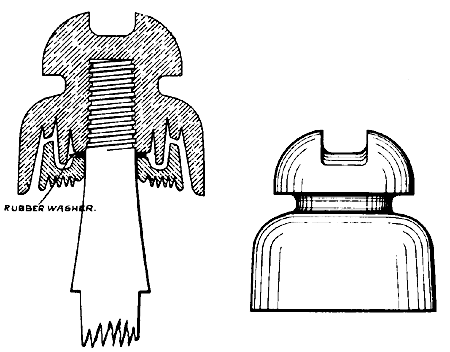[Trade Journal]
Publication: The Journal of Electricity, Power and Gas
San Francisco, CA, United States
vol. XXVIII, no. 6, p. 121, col. 1-2
BETTER INSULATION.
From the first days of the telegraph, more than sixty years ago, it has been the aim of the transmission companies to find an insulator that would remain an insulator in good weather and in bad. Up to the present time it has been the expectation that during a drizzle or a fog, the wire facilitaties [sic] facilities would be materially lessened owing to leakage and the cross-fire that takes place on every crossarm.
 |
| Type of Insulator Used in Test. |
Now comes the "Noleak" insulator, in which the under part, that is the petticoats, and the space between the petticoats, is protected from dust and moisture. A dry clean space is always present between the conductor and the pin. This effectively stops the leakage that must always obtain with the ordinary insulator when it becomes dirty.
About two years ago the Journal made mention of this new insulator, and in view of the importance of improved insulation it now takes pleasure in giving the results of a test of twenty-eight months on 71 miles of line through a fog belt along the coast of Southern California.
After five months use the following report was made:
"The difference in the actual working of the two wires was very noticeable. No. 2 was very heavy and San Diego had difficulty in adjusting, while No. 4 (equipped with "Noleak" insulator) was clear and could have been worked at high speed."
After seventeen months' use the conditions were stated thus:
"Since the installation of the "Noleak" insulators there has been a great improvement in the working of the two wires. The cross-leak has been reduced to a point where it does not trouble us, and the two wires have been simultaneously workable. Normally the wire insulated with the "Noleak" insulator shows from one-fifth to one-half the escape of the other wire. The elimination of the cross-leak, however, is the best achievement of three insulators, and I believe it is only fair to give them full credit, as the cross-leak has certainly been eliminated since the "Noleak" insulators were put on."
After twenty-eight months' service this statement was given:
"The conditions are practically the same as when I wrote you a year ago."
The chief object sought for by the designer of this insulator, L. W. Storror, who has been prominently identified with the telegraph and telephone service on the Pacific Coast for many years, was to overcome the leakage and cross-fire which threw the greater portion of the lines in the fog belts out of commission every time there was a fog or a drizzle. How successfully this object has been accomplished is shown by the foregoing records.
A more recent series of tests, extending over a period of six months, has just been made. In July, 1911, one pair of aerial wires across Goat Island was equipped with new standard D.P. Insulators, and another pair of wires was equipped with Noleak Insulators. Tests have been made twice a day on seventy-nine days since October 20th, 1911. The lowest measurements of each wire, taken at the same time, indicate that the Noleak Insulator has one hundred and eighty-four per cent greater efficiency than the standard D.P. Insulator.
With this will be found a sketch of the latest pattern of the Noleak Insulator. Eight and one-half inches of insulating surface intervenes between the line wire and the pin, and it is claimed that one-half of this distance will always remain clean and dry.
Insulation experts have declared that sixteen per cent increased distance between line and pin means 100 per cent greater efficiency. The new form of insulator has 25 per cent more insulating distance than the form upon which the tests were made.
